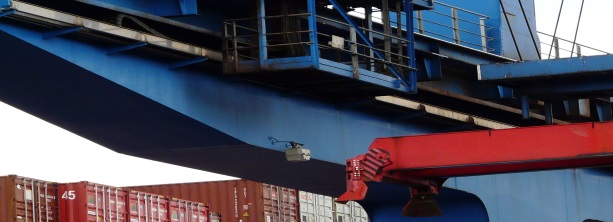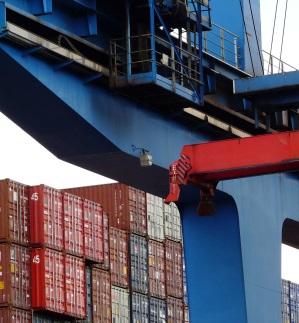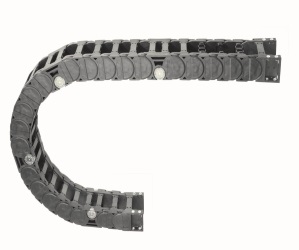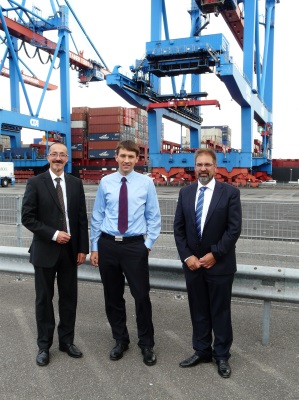
Twelve years under extreme stress
Fourteen container gantry cranes at the HHLA Container Terminal Altenwerder (CTA) are equipped with energy chains to supply the gantry trolleys with energy and signals. The chainflex cables have been working for twelve years now trouble-free at very high loads and have already completed some 1000 km distance in that time. CTA was at that time a pioneer in the use of energy chains and highly flexible cables. Today, this solution has become established worldwide.
CTA: These three letters stand for the highest productivity in container handling. Because they stand for "Container Terminal Altenwerder" at the Hamburg harbour. The terminal operator, the Hamburger Hafen und Logistik AG (HHLA), handled 1.9 million TEUs in its four container terminals in just the first quarter of 2014. With the Container Terminal Altenwerder, HHLA operates by its own account one of the most productive and most modern container handling facilities in the world even twelve years after its commissioning.
Container gantry cranes: Two-stage transport accelerates handling of cargo
The quay of the CTA can accommodate four large container ships that can be loaded and unloaded by 14 container gantry cranes. The transport of containers into block storage is undertaken by driverless transport vehicles ("automated guided vehicles" - AGVs) and even the two-trolley container gantry cranes themselves are designed for maximum handling capacity. The main trolley undertakes the transport from the ship to a platform that is located centrally on the gantry. From there a second trolley - the gantry trolley - carries the container fully automatically on one of the AGVs.
New paths in energy supply
Not only with conceptual issues, such as the two-trolley principle and the AGVs, those in charge of the CTA pioneered new ways. The energy supply system to the trolleys of "ship to shore" cranes (StS) was carried out twelve years ago usually with festoon systems. In the two-trolley cranes, the designers who were responsible for the drive and control technology however decided to use energy chains for the initial supply of the gantry trolley. Because this type of energy supply system has been credited with a longer service life. In addition, the energy chains enable a more compact design: The chain takes up less space than a festoon, which would in this case require a loop length of about eight metres.

Highly visible and well integrated into the design: The energy chain takes over the supply of the gantry trolley with energy and data. (Source: igus GmbH).
Movable cables have been in operation for twelve years
The initial supply of one StS container crane with an energy chain instead of a festoon was at that time a novelty. So it was quite natural that the industry observed this "experiment" with attention.

The correct moving cable for every application: The product range of highly flexible chainflex has been expanding continuously. (Source: igus GmbH).
No one can judge the experiences the terminal operator has had with the energy chains until today better than the Dipl.-Ing. Jan Porwit, the technical head of the large appliances division. At the CTA subsidiary, SCA GmbH, (the acronym 'SCA' stands for "Service Center Altenwerder") he and his staff are responsible for the service and maintenance of the cranes in the large appliances division. At the CTA subsidiary, SCA GmbH, (the acronym 'SCA' stands for "Service Center Altenwerder") he and his staff are responsible for the service and maintenance of the cranes in the large appliances division. His team has few problems with the energy supply of the gantry trolleys: "The first chainflex cable set is still installed in the energy chains. Only the mechanical components of the chains were changed in 2008 due to wear and replaced by a 'heavy duty' version, which was newly developed by igus. However, we retained the chainflex cables in the process. They have already handled more than 100,000 container movements. “

Proven in highly stressed operations: The "heavy duty" version of the E4 energy chain. (Source: igus GmbH).
High speed and heavy duty: No cables "off the shelf"
The main reason for the long service life is the fact that highly flexible cables from the chainflex range from igus are used in the energy chains, which were developed and manufactured from scratch for mobile applications. In the 2,750-square-metre test laboratory in Cologne, the largest for moving cables, two billion test cycles of chainflex cables are carried out per year. Thus new structures are developed and the manufacturing processes continuously monitored and evaluated.
When selecting the cables, the specialists from igus collaborated closely with Siemens AG, which was responsible for the development of the drive and control technology of the container gantry cranes. Thus igus suggested, for example, the CF-300 single core cables with cross-sections of 1 x 120 mm2 to ensure the power supply of the two 364 kW hoist motors. These cables need a smaller bending radius and save weight compared to conventional multi-core cables. They allow a more even weight distribution in the energy chain and resist "corkscrews" and thus avoids an undesirable twisting of the cables.
Advantages over other systems
Besides the energy supply, the signal and data transport is also ensured by the energy chain. Here, besides the control cables of the series CF 9 and motor cables of type CF 34 in different dimensions, the "twisted pair" data cables of the series CF 11 are also used. Moreover, fibre optic cables from the chainflex range provide the connection to the sensors.
Since a lot of cables are required overall to supply the gantry trolley with energy and signals, two counter-running energy chains of the type E4 5050 RHD are installed on the container gantry cranes. They weigh from 13 to 15 kg per metre. The cable load is around 14 kilograms per metre of chain. Rainer Rössel, head of the chainflex division at the igus GmbH: "A festooning is about 30 percent heavier because the cable length is about 50 percent longer based on the system and the weight per metre of the cable festoon is higher. " The higher weight is due to the fact that the cable festoons must protect themselves from damage caused from outside. This is generally done by very thick, heavy rubber outer jackets, and sometimes also steel supporting elements which contribute accordingly to the high weight. "In our system, the chain is responsible for the protection and the safe guiding of the cables," said Rainer Rössel. "For this reason, chainflex cables can be equipped with innovative and significantly lighter materials, which are at the same time extremely resistant to abrasion and flexible. " Thus the energy chain system of igus saves space and weight as well as spare additional steel construction in the entire system.
Important: Energy chain and cable from a single source
That the required protective effect is provided in spite of the lower weight demonstrates the long service life of the energy supply to the CTA cranes. In addition, CTA and igus dismantled and tested a control cable after six years. The result: The cable was still as good as new after a six-digit number of cycles. The contributing factors for this were the highly abrasion-resistant jacket made of TPE compound specifically developed in-house for this purpose, as well as the choice of materials for insulation, the type of stranding of the cables and the production according to extremely high quality standards.
Decisive for the long life of an energy chain system, however, is the requirement that chain and cables are developed for joint use and for continuous movement, because movement is the main cause of wear. What counts here is the experience of the developers, and which has been given 100 percent at igus. Finally, for over 20 years the company has been focusing on cable systems in motion. And in every single chain the division is individually determined so that a uniform load is placed in movement.
Highest service objective: Preventing failures
The energy chains for the CTA cranes were produced in Cologne in 2002 as "readychain". It means: The chains were filled, provided with all accessories and mounting brackets and delivered together with trough, ready for connection to the manufacturer of the container gantry cranes. Since November 2002, they have been in use at the Terminal Altenwerder. Since then the SCA service technicians have been regularly performing visual inspection on the chains.

From left to right: Dipl.-Ing. (FH) Rainer Rössel, head of the igus chainflex cables division, Dipl.-Ing. Jan Porwit, head of large appliances technology at the SCA Service Center Altenwerder GmbH and Theo Diehl, head of the crane and materials handling industry division at the igus GmbH. (Source: igus GmbH)
Jan Porwit: "Internal damage to cables are difficult to detect, so that we have defined together with igus a list of criteria for the visual inspection, which we execute to keep our preventive maintenance policy in perfect shape. “
Conclusion: A solution that has prevailed
The operators of the CTA have fared well so far with the igus cable systems in the truest sense of the word. Twelve years ago the decision for an energy chain was courageous - experience shows that it was right. Meanwhile, the energy chain has established itself worldwide in combination with the chainflex cables. Thus more than 650 ship to shore cranes have been equipped with energy chains since then. For the RTG, RMG and ASC, which are used for container handling in the container warehouse, the market share is well over 60 percent. Thus, energy chains from igus are today "state of the art" in harbour cranes of all kinds.
 chainflex cables - product overview
chainflex cables - product overview
Inform, select and order online.
The igus® laboratory
igus® laboratory and practical in: 2,7502laboratory, more than 15,000 tests per year, 1000 data records
E-Chain® Applications Overview
Overview of the E-ChainSystem® applications



